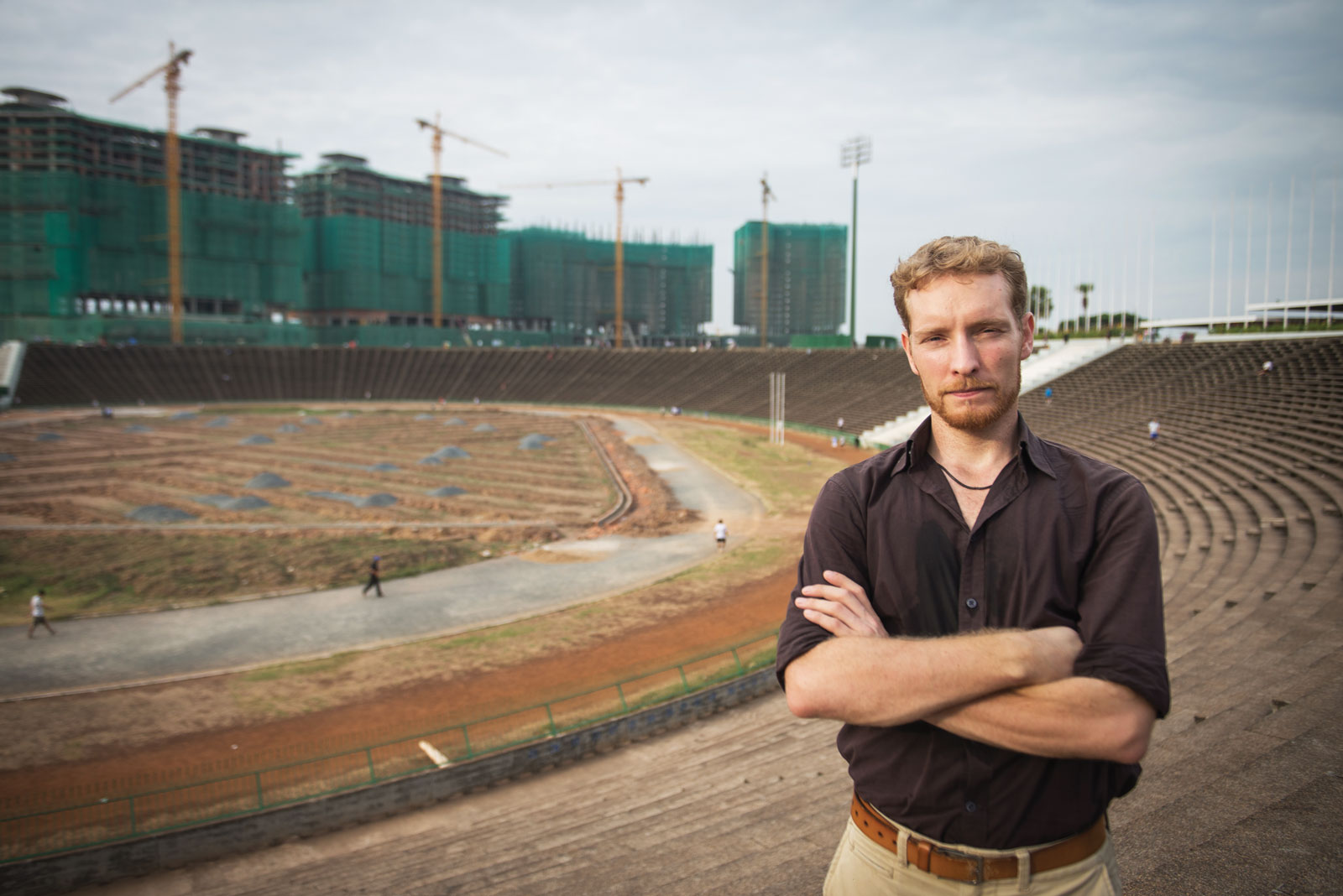Sitting on the concrete steps inside Phnom Penh’s Olympic Stadium a claustrophobic feeling hangs in the air: almost as if the edges of this historic structure are being squeezed in a vice. On one side stands City Mall and the spindly cranes of the luxurious Sky Villa condominiums; on the other side, the four towers of the giant Olympia City project loom menacingly. Over the years, all of these developments have gradually whittled away much of the stadium’s land.
“Vann Molyvann believes that Phnom Penh isn’t for the people nowadays – it’s being sold off and developed for a small section of society,” says Christopher Rompré. “Take the Olympic Stadium, which is the biggest public space for people in the city – it’s being sold off, piece by piece.”
Rompré and Haig Balian, co-founders of LittleBIG Films, a Cambodia-based video production team, have been working on a 30-minute documentary, The Man Who Built Cambodia, about the legendary architect Vann Molyvann.
“About a year ago, I was introduced to Bill Greaves, director of the Vann Molyvann Project,” explains Balian. “We got talking, and I’d never really heard of Vann before, but it was such an interesting issue. So we decided to pursue this project as a documentary.”
Coming from a humble, rural family in Kampot province, Vann Molyvann earned a scholarship to study architecture at the Ecole Nationale Supérieure des Beaux-Arts, one of the finest schools in Paris. After a decade spent abroad honing his skills, he returned to Cambodia and, with the backing of Prince Norodom Sihanouk, was instrumental in instigating the country’s ‘golden age’ of architecture. Over the course of his career, he designed landmarks including Olympic Stadium, Chaktomuk Conference Hall, the famed Independence Monument and had a hand in the design of the port city of Sihanoukville. He also worked for the UN Human Settlements Programme for ten years and, in 1991, was appointed Minister for Culture, Fine Arts and Town and Country Planning in Cambodia.
As Phnom Penh undergoes radical alterations, many of Vann Molyvann’s original constructions are under threat and the ageing architect has become a vocal critic of the capital’s development.
How does Vann Molyvann feel about development in Phnom Penh and about his own legacy?
HB: He’s certainly pessimistic. He sees his buildings as his family, so them being neglected or torn down is very upsetting for him. But the documentary isn’t just about his buildings, it’s about the state of development in Phnom Penh: What are Cambodians going to be left with? What is their capital going to develop into? What is their attitude to development likely to be?

CR: In his later years as an architect he was thinking more broadly and about the city as an organic being with needs. In the documentary he speaks about his regret over the lack of a Khmer architecture [style] at the moment – there’s just a hodgepodge of structural styles from other countries and cities. We think it’s a really timely film.
He feels there’s no Khmer identity in the country’s architecture?
CR: He’s quite disappointed there hasn’t been any leadership over city planning. Phnom Penh was a regional leader in creative design and thoughtful public space, and he sees development now being led by petty, private interests, rather than a vision for Phnom Penh as a space for its inhabitants.
Was he receptive to a documentary being made about him?
HB: He’s been approached by people before for interviews and such but hasn’t had much come from it. We contacted his daughter, Delphine, who protects him so he’s not bombarded with requests. She ensured that what we were doing was worthwhile; then she spoke to him and got him onboard. Now he’s seen the trailer, he’s quite enthusiastic.
What can we expect from the film?
CR: We have tried to do three things: Firstly, to chronicle this incredibly unique and talented man who has had a fascinating and very rich life. Secondly, we want to talk about his architecture and how special it was: It came from a modernist school, but it uniquely sprang from nature and the environment, it used sustainable design features, such as airflow, shading and passive, solar design elements.
Finally, using Vann Molyvann’s story, the documentary will reflect on modern-day Cambodia and the architecture of the capital. The central theme of it is comparing his exciting, revolutionary designs that were springing up in the 1960s to the bland buildings we see today. I hope that this will be a film for Cambodians, so I feel some pressure to tell the story accurately.
HB: We’re hoping to show it at the Chaktomuk Conference Hall – one of Vann’s buildings – and through the Asia Foundation online. We’re also hoping to tour it around Cambodia, and it will be available in English, Khmer and possibly French as well.
What do you hope people will take away from the film?
CR: Recently, there’s been a renaissance in Cambodian rock’n’roll and the ‘golden era’ of film, which looks back at the past and adapts it for the future. I hope the documentary can inspire a similar renaissance in Cambodian architecture. What made Vann Molyvann’s work special was the passion and creativity at that time, and we’ve seen many young architects today who are passionate about Vann’s work but are also brimming with new ideas.
Finally, what does the future look like for LittleBIG Films?
CR: The documentary is very exciting for us as it’s a new step. We mainly work with NGOs, making short documentaries for them, but this is the first time we’re not working for anyone but ourselves and in which we can tell the story we want to tell. It’s the first step for us and one we always wanted to make to be independent documentarians.

